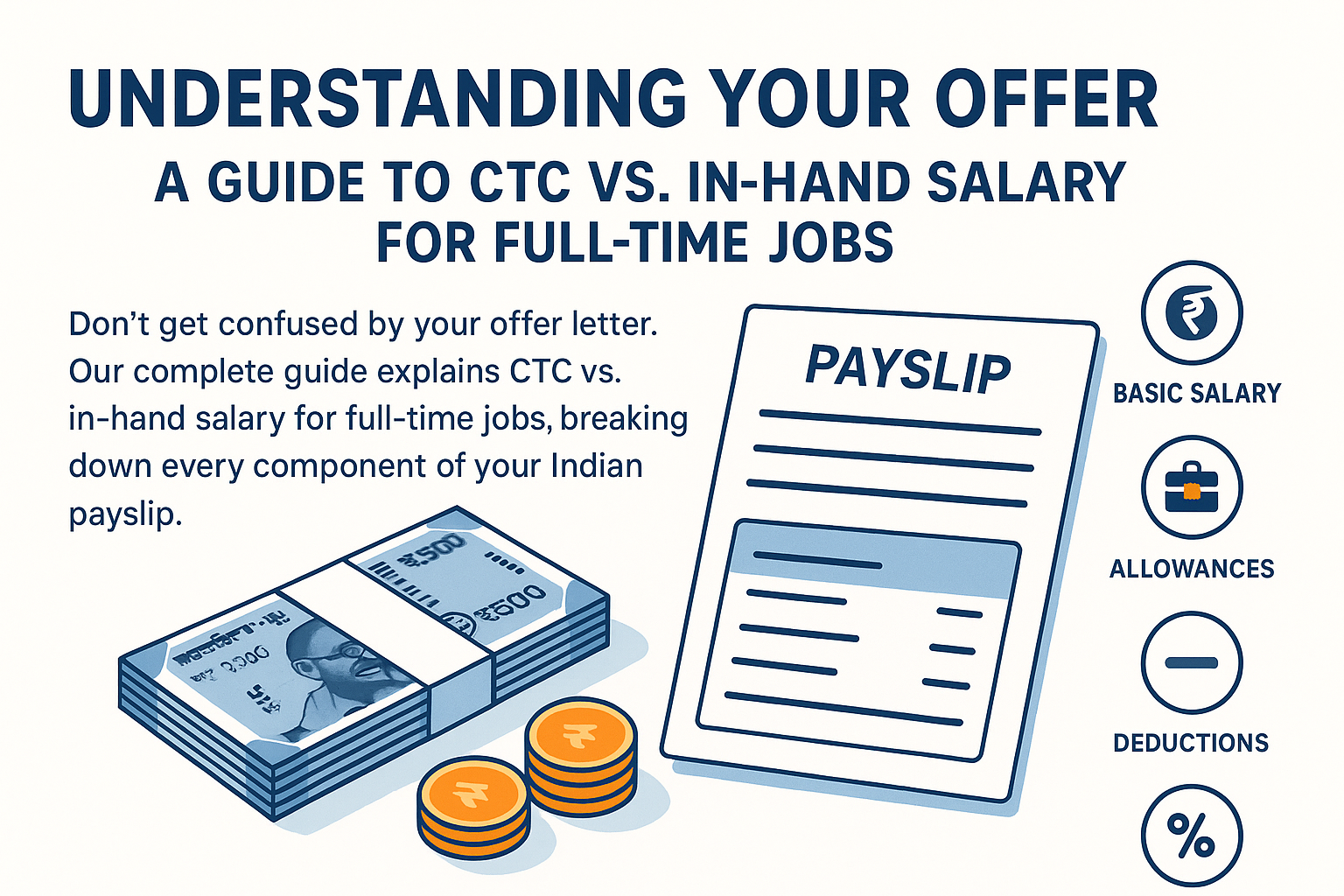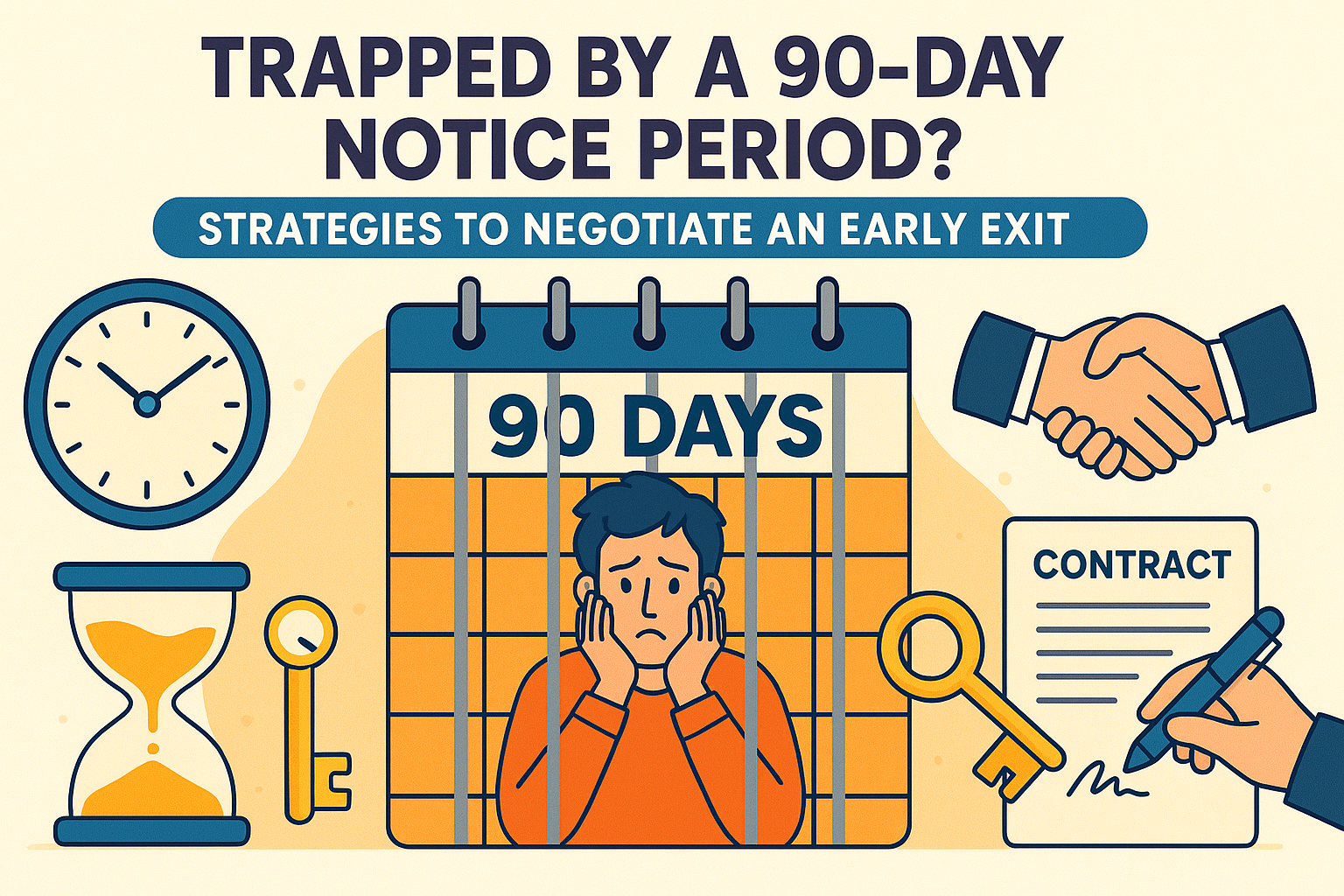
Understanding Your Offer: A Guide to CTC vs. In-Hand Salary for Full-Time Jobs
It’s the exhilarating final step of a long and challenging journey. After crafting the perfect resume, navigating multiple interview rounds, and patiently waiting, you finally receive the email you’ve been hoping for: the offer letter for a new full-time job. Your eyes immediately find the compensation section, and you see the big, bold number next to the letters "CTC." A surge of pride and excitement is quickly followed by a mental calculation as you divide that Cost-to-Company figure by twelve to figure out your new monthly income.
But if this is your first time receiving a formal offer for a full-time job, that calculation is setting you up for a major surprise. When your first payslip arrives, the number credited to your bank account—your "in-hand" salary—will be substantially lower than what your simple division predicted. This gap between the headline CTC and your actual take-home pay is a universal point of confusion and is the single most important financial concept a professional in India needs to understand. It’s the difference between what a company spends on you and what you actually earn.
Understanding this difference is not just an academic exercise; it's a fundamental aspect of financial literacy and career management. It empowers you to accurately compare job offers, negotiate with confidence, and plan your personal finances with a realistic picture of your income. A high CTC can be incredibly appealing, but if it's structured in a way that results in a lower-than-expected in-hand salary, it might not be the best offer on the table.
This guide is designed to be your comprehensive decoder for the Indian salary structure. We will demystify the jargon, break down every component of your offer letter, and explain the journey of your salary from the gross CTC figure to the net amount in your bank account. By the end of this article, you will be able to read any offer letter like a seasoned professional, ready to make the best possible decision for your career.
The Big Picture: What is Cost-to-Company (CTC)?
Let’s start with the number that gets all the attention. The Cost-to-Company (CTC) is exactly what its name implies: it is the total cost that a company will incur by having you as a full-time employee for one year. It's the company's entire budget for your role. Think of it as the total value of your employment package from the employer's perspective.
It’s crucial to understand that CTC is not your salary. It is a combination of direct payments to you, indirect benefits that the company pays for on your behalf, and long-term savings contributions. The basic formula is:
CTC = Direct Benefits (Salary) + Indirect Benefits (Perks) + Saving Contributions (Retirals)
Because it includes components that you don't receive in your monthly payslip, the CTC will always be higher than your take-home pay. Let's break down each of these components.
The Components of Your Salary: Direct Benefits
These are the parts of your CTC that form the basis of your monthly earnings before any deductions are made.
The Foundation: Basic Salary
This is the single most important number in your entire salary structure. The Basic Salary is the fixed, core part of your compensation. It is fully taxable. In India, it typically makes up about 40% to 50% of your total CTC. Almost all other major components of your salary, such as Provident Fund (PF) contributions and sometimes House Rent Allowance (HRA), are calculated as a percentage of this basic figure. Therefore, a higher basic salary is generally very beneficial for your long-term financial health and retirement savings.
The Allowances: Covering Your Expenses
Allowances are additional sums of money given to you to cover specific expenses. They are added to your basic salary. * House Rent Allowance (HRA): This is a significant component provided to help you cover the cost of rental accommodation. HRA is a powerful tool for tax savings. You can claim a tax exemption on your HRA based on a specific formula that considers your basic salary, the city you reside in (metro or non-metro), and the actual rent you pay. * Leave Travel Allowance (LTA): This allowance covers travel expenses for you and your family for vacations within India. You can claim tax exemption on your LTA for two journeys in a block of four calendar years by providing actual travel receipts. * Conveyance or Transport Allowance: This is a payment to cover your daily commute between your home and the office. * Special Allowance: This is often the "balancing" component in a salary structure. It is a fully taxable allowance that the company uses to make up the difference between the sum of all other components and the total promised CTC.
The Perks and Privileges: Indirect Benefits
These are benefits that you don't receive as cash but still have significant monetary value. The company pays for these on your behalf, and the cost is included in your CTC.
- Health Insurance: The annual premium paid by your company for your group medical insurance policy is a common indirect benefit.
- Subsidized Meals: If your company provides free or heavily subsidized lunches or snacks through a cafeteria, the cost of that subsidy is part of your CTC.
- Company Transport: If you use a company-provided bus or cab service for your commute, the cost is factored into your compensation package.
The Deductions: Where Your Money Goes
This is the part of the equation that explains the difference between your gross monthly salary and your net take-home pay. These amounts are deducted from your gross earnings each month.
Long-Term Savings: Your Retirals
- Employees' Provident Fund (PF): The EPF is a mandatory retirement savings scheme. Every month, 12% of your basic salary is deducted and deposited into your PF account. Your employer makes a matching contribution of another 12% of your basic salary. Your contribution is a deduction from your gross salary, while the employer's contribution is an additional cost to the company (and is also included in your CTC). This is a fantastic, government-backed, long-term investment tool.
- Gratuity: This is a statutory benefit paid to you by the employer as a reward for your long-term service. It is payable when you leave the company after completing at least five years of continuous service. A portion of your CTC is allocated by the company towards a gratuity fund for this future payment.
Taxes and Duties
- Professional Tax: A small, state-level tax levied on all salaried individuals. The amount is usually a fixed sum (e.g., ₹200 per month) and is deducted from your gross salary.
- Tax Deducted at Source (TDS): This is the income tax that your employer is legally required to deduct from your salary each month and pay to the government on your behalf. The TDS amount is calculated based on your total annual income and the income tax slab you fall under. You can reduce your taxable income, and thus your TDS, by investing in tax-saving instruments and declaring them to your employer.
From CTC to Gross to In-Hand: The Final Calculation
Now, let's put all the pieces together to understand the final numbers.
- Gross Salary (Monthly): This is your total salary earned in a month before any deductions are made. It is calculated by adding your Basic Salary and all your allowances.
- Net Salary or In-Hand Salary (Monthly): This is the final amount that gets credited to your bank account. It is your Gross Salary after all deductions (your PF contribution, Professional Tax, and TDS) have been made.
A Quick Example
Let's assume a full-time job offer with a CTC of ₹10 Lakhs per annum. A possible structure could be: * Basic Salary: ₹4,00,000 * HRA: ₹2,00,000 * Special Allowance: ₹2,98,400 * Employer's PF Contribution: ₹48,000 (12% of Basic) * Gratuity: ₹19,200 * Health Insurance Premium: ₹34,400 * Total CTC: ₹10,00,000
Your monthly Gross Salary would be (Basic + HRA + Special Allowance) / 12 = ₹78,200. From this, your monthly deductions would be approximately: * Your PF Contribution: ₹4,000 * Professional Tax: ₹200 * TDS (estimated): ₹7,000 - ₹9,000 (depending on your tax planning)
So, your monthly In-Hand Salary would be roughly ₹65,000 - ₹67,000. As you can see, this is a world away from the ₹83,333 you might have initially calculated by simply dividing the CTC by 12.
Conclusion: Empower Yourself Before You Accept
Understanding the components of your salary is a fundamental skill for any professional. It allows you to move beyond the tempting headline CTC and evaluate a job offer based on its true financial value. When you receive an offer for a full-time job, always ask for a detailed salary breakup. Analyze the percentage of the Basic Salary, the tax-saving potential of the allowances, and the quality of the indirect benefits.
This knowledge empowers you to negotiate more effectively. You can negotiate not just the total CTC, but also its structure. For example, you could ask for a higher basic salary component to maximize your long-term savings.
A great job offer is the culmination of a successful job search. It starts with a powerful resume, crafted with a tool like the JobPe Resume Builder, that effectively showcases your value. It continues through a confident interview performance, honed by practicing with common interview questions. And it ends with a clear-eyed, informed evaluation of the offer on the table. To ensure you’re getting a steady stream of such offers, set up targeted job alerts for roles that meet your career goals.
By demystifying your payslip, you are taking control of your financial future and making a career decision with the clarity and confidence you deserve. For more resources to help you at every stage of your career, visit us at https://jobpe.com.

Creative Content Writer






